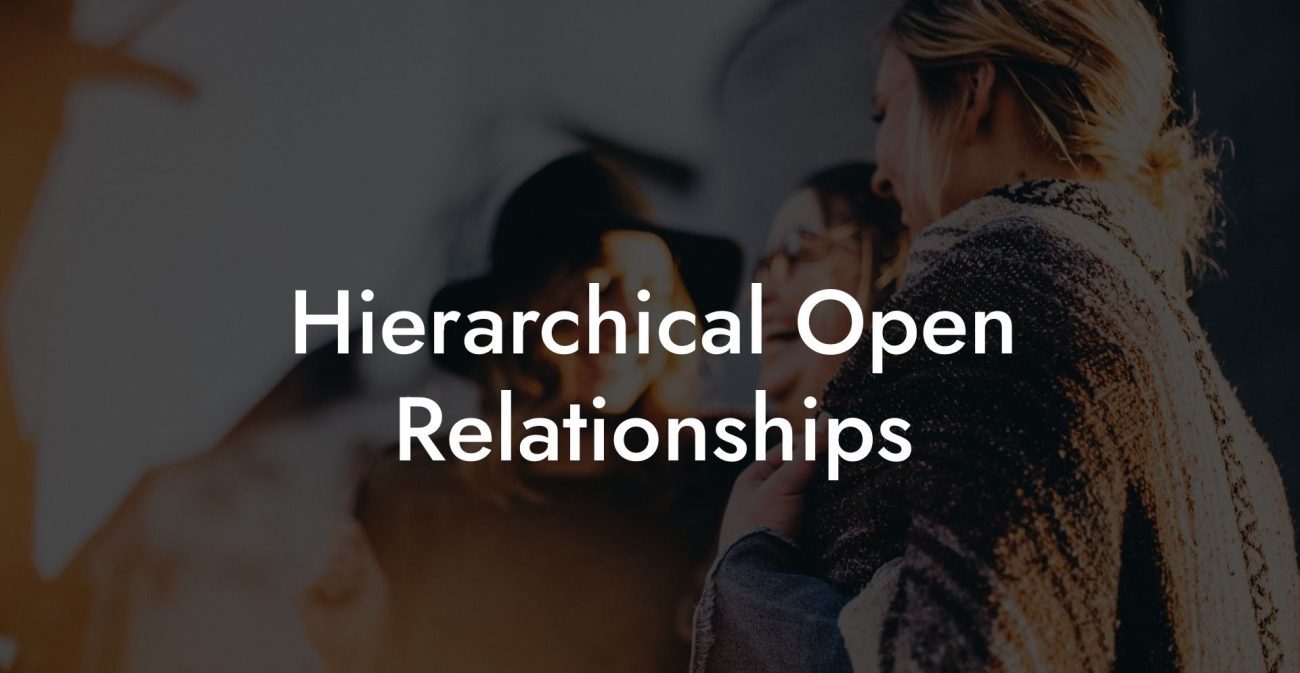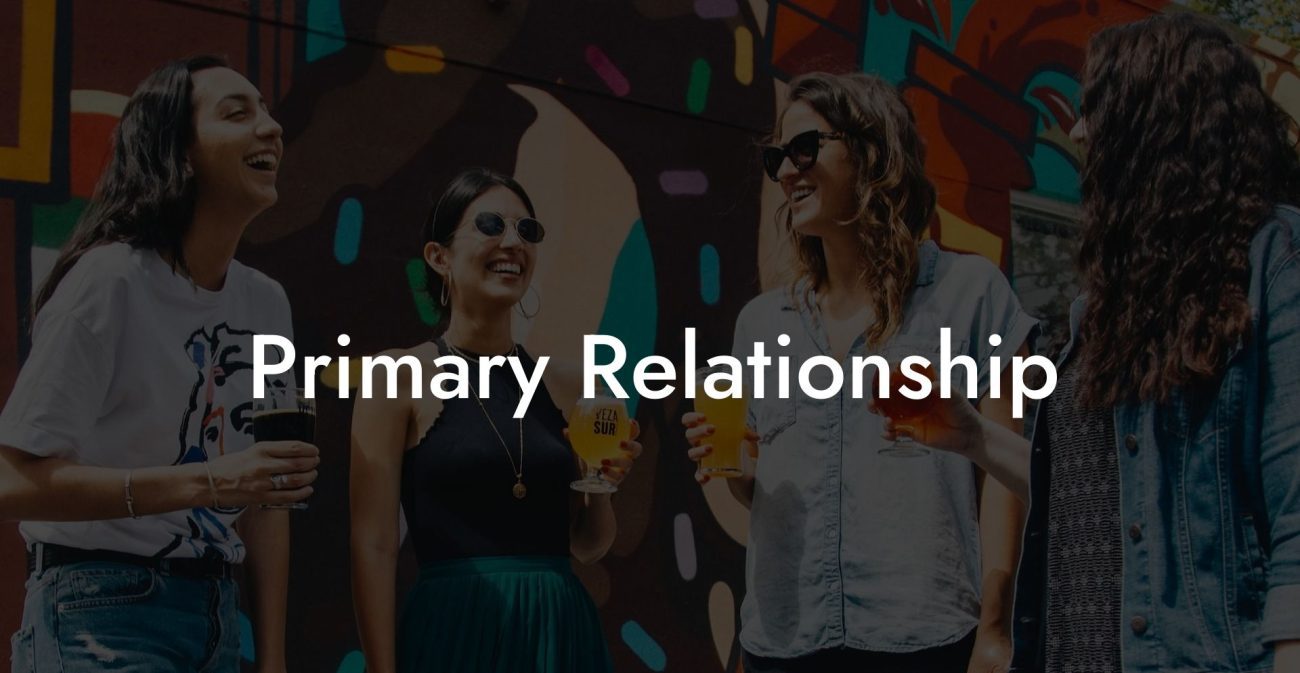Secondary Partner

Imagine a symphony where every instrument plays a unique, indispensable role—each note contributing to a harmonious, balanced masterpiece. In the intricate world of relationships, a secondary partner is that essential melody that enriches your life, offering support, variety, and unique perspectives without overshadowing the central theme. Whether you’re part of a monogamous duo exploring new dimensions of connection or navigating the complex waters of ethical non-monogamy, understanding the role of a secondary partner is key to building a fulfilling, multi-layered relationship network. This guide to Secondary Partners delves into the definition, roles, benefits, challenges, and practical strategies for nurturing these important connections, empowering you to honor every relationship’s unique contribution.
Have you ever wondered if monogamy is just a stupid little experiment? Open relationships, polyamory, relationship anarchy...find out which relationship dynamic suits you best with our one minute relationship test. See if you are just conforming to "societal norms". Reveal your truth >>
Quick Links to Useful Sections
- Understanding the Secondary Partner
- Defining the Concept
- The Role of a Secondary Partner
- Emotional and Social Support
- Flexibility and Freedom in Connection
- Benefits of Secondary Partnerships
- Diverse Emotional Support
- Opportunities for Personal Growth
- Increased Flexibility and Autonomy
- Complementary Dynamics to Primary Relationships
- Challenges of Being a Secondary Partner
- Feelings of Insecurity or Being “Less Important”
- Balancing Time and Emotional Energy
- Communication Complexities
- Social Stigma and External Perceptions
- Strategies for Nurturing a Healthy Secondary Partnership
- Foster Open and Honest Communication
- Establish Clear and Flexible Boundaries
- Prioritize Self-Care and Personal Growth
- Utilize Digital Tools for Coordination
- Build a Supportive Community
- Embrace Flexibility and Adaptability
- Integrating Secondary Partnerships with Primary Relationships
- Understanding the Relationship Spectrum
- Collaborative Negotiation of Time and Resources
- Real-Life Examples and Success Stories
- Case Study: Casey’s Journey of Balance
- Case Study: Jordan’s Experience in a Multi-Partner Network
- Expert Insights on Secondary Partnerships
- FAQ: Your Secondary Partner Questions Answered
Understanding the Secondary Partner
Defining the Concept
A secondary partner is typically someone with whom you share a meaningful connection that, while significant, does not carry the same level of commitment, time, or responsibility as your primary partner. In many non-monogamous relationship structures, a secondary partner is a key component of your emotional network—offering additional support, intimacy, and companionship—without being the central focus of your life.
It is important to note that the term “secondary” does not imply any lesser value. Instead, it distinguishes the different levels of emotional, logistical, or financial integration that each relationship may have. In traditional monogamy, the notion of a secondary partner is usually absent because the focus is solely on a single, exclusive bond. However, in open, polyamorous, or non-traditional relationship structures, secondary partnerships provide diversity and depth to your overall relational experience.
The Role of a Secondary Partner
Emotional and Social Support
Secondary partners often bring a different kind of emotional energy to your life. They might offer fresh perspectives, creative inspiration, or simply a reliable friend to confide in during both the highs and lows. While your primary partner might be your emotional anchor—the one with whom you share long-term plans and deep vulnerability—a secondary partner can add a layer of diversity to your support network. Their presence can be uplifting, stimulating, and, at times, even cathartic.
In many cases, secondary partners are those who connect with you on interests, values, or hobbies that differ from the more intimate, all-encompassing bond you share with your primary partner. This balance allows you to experience various facets of your personality, enriching your emotional landscape.
Flexibility and Freedom in Connection
The role of a secondary partner is also defined by its inherent flexibility. Because these relationships typically come with fewer obligations than a primary partnership, they allow both individuals to explore their interests and maintain a sense of independence. This freedom can be particularly refreshing for those who value self-growth and autonomy, as it provides a space where both parties can connect deeply without the pressure of long-term exclusivity.
This flexibility means that secondary relationships can evolve over time. For some, what begins as a casual or exploratory connection may deepen and take on more significance. For others, the relationship might remain fluid, providing occasional companionship or support when needed. The key is that every relationship is negotiated with mutual consent and clear communication, ensuring that all parties feel respected and valued.
Benefits of Secondary Partnerships
Diverse Emotional Support
One of the most significant benefits of having secondary partners is the richness and variety they add to your emotional support system. With a secondary partner, you have the opportunity to experience different kinds of intimacy and care. For instance, while your primary partner might offer stability and a deep emotional anchor, your secondary partner may bring in elements of playfulness, creativity, or intellectual stimulation.
This diverse support system means that no single person is expected to meet all your emotional needs, reducing the pressure on any one relationship and promoting a more balanced, sustainable approach to love.
Opportunities for Personal Growth
Engaging in multiple relationships—each with its own dynamic—forces you to become more self-aware. With a secondary partner, you learn to navigate boundaries, manage time, and communicate effectively in different relational contexts. These experiences can lead to significant personal growth as you become more adept at understanding your needs and negotiating your expectations.
This growth not only enriches your secondary relationship but also enhances your overall ability to form and maintain healthy connections, whether with a primary partner or in other areas of life.
Increased Flexibility and Autonomy
Secondary partnerships are often characterized by a greater degree of freedom and flexibility. They allow you to explore different aspects of your personality and interests without the weight of extensive obligations. This dynamic can be empowering, as it encourages you to be true to yourself while still enjoying the benefits of connection.
The flexible nature of secondary relationships means you can adjust the level of involvement as your personal circumstances change, ensuring that each connection remains a source of joy rather than a constraint.
Complementary Dynamics to Primary Relationships
In non-monogamous setups, secondary partners complement your primary relationship by offering alternative perspectives and forms of support. This complementary dynamic can add depth to your emotional life, as each relationship contributes uniquely to your overall well-being. It also helps prevent the isolation that might occur if one person were solely responsible for fulfilling all your needs.
Challenges of Being a Secondary Partner
Feelings of Insecurity or Being “Less Important”
One common challenge in secondary partnerships is the perception of being less important than a primary partner. This feeling can lead to insecurities and doubts about your value within the relationship network. It is crucial for both you and your primary partner to communicate openly about the roles and expectations to ensure that every partner feels valued.
Addressing these feelings head-on through honest dialogue and self-reflection is key to overcoming any sense of inadequacy.
Balancing Time and Emotional Energy
Managing your time and energy across multiple relationships can be a significant challenge. As a secondary partner, you may sometimes feel that you receive less attention or that your needs are less prioritized. Balancing these dynamics requires clear communication and a willingness to negotiate time commitments so that every relationship feels nurtured.
Using digital tools like shared calendars and regular check-ins can help mitigate these challenges and ensure a more balanced distribution of emotional investment.
Communication Complexities
When you’re navigating the nuances of a secondary relationship—especially within a larger network—communication can become complex. Misunderstandings may arise if expectations are not clearly defined, or if there is a lack of transparency about the nature of the relationship. Ensuring that you and your partners have clear, ongoing dialogue is essential for preventing conflicts and fostering trust.
Social Stigma and External Perceptions
Secondary partners may sometimes face social stigma or feel undervalued due to cultural norms that prioritize exclusive, monogamous relationships. External judgments can affect your self-esteem and add pressure to prove your worth. Building a supportive community of like-minded individuals and educating those around you about the benefits of diverse relationship structures can help counteract these negative perceptions.
Strategies for Nurturing a Healthy Secondary Partnership
Foster Open and Honest Communication
Regular, transparent communication is the cornerstone of any successful secondary partnership. Engage in frequent check-ins where you can share your feelings, discuss expectations, and address any issues before they escalate. Use “I” statements to express how you feel and encourage your partners to do the same.
In non-monogamous settings, it might be helpful to have both group discussions and one-on-one conversations to ensure that each relationship receives the attention it needs.
Establish Clear and Flexible Boundaries
Boundaries are essential for protecting your emotional well-being and ensuring that your role as a secondary partner is respected. Clearly define what you are comfortable with in terms of time, intimacy, and emotional investment, and communicate these boundaries openly with your partner(s). Be prepared to revisit and adjust these boundaries as your needs and circumstances evolve.
Documenting your agreements—using digital notes or a shared document—can help keep everyone on the same page and prevent misunderstandings.
Prioritize Self-Care and Personal Growth
Taking care of yourself is vital. Engage in regular self-care practices such as exercise, meditation, or creative pursuits to ensure you remain emotionally and physically balanced. Self-reflection through journaling or therapy can also provide insights into your personal needs and help you manage any feelings of insecurity.
Remember, a healthy secondary partnership starts with a strong sense of self. When you invest in your own well-being, you’re better equipped to contribute positively to all of your relationships.
Utilize Digital Tools for Coordination
Digital tools can be invaluable for managing multiple relationships. Use shared calendars, scheduling apps, and digital journals to coordinate your time, track commitments, and facilitate regular communication. These tools help ensure that every partner—primary or secondary—receives the attention and care they deserve.
Build a Supportive Community
Connect with others who navigate similar relationship dynamics by joining online forums, social media groups, or local meet-ups focused on ethical non-monogamy. A supportive network can provide validation, practical advice, and a safe space to share experiences. This community support can be particularly important if you face external judgments or social stigma.
Embrace Flexibility and Adaptability
Recognize that your role as a secondary partner may evolve over time. Stay open to renegotiating boundaries and adjusting your level of commitment as your needs and the dynamics of your relationships change. Flexibility is key to maintaining healthy, dynamic connections.
Integrating Secondary Partnerships with Primary Relationships
Understanding the Relationship Spectrum
In many non-monogamous structures, secondary partnerships coexist with a primary relationship. It’s important to understand that these roles are not meant to compete but rather to complement one another. Your primary relationship may provide a deep, stable foundation, while secondary partnerships offer additional support, excitement, or creative inspiration.
Clear communication and boundary-setting between all parties can help ensure that the needs of the primary relationship are met while still honoring the contributions of secondary partners.
Collaborative Negotiation of Time and Resources
One effective strategy is to use collaborative negotiation to allocate time and resources fairly. This might involve setting up a shared digital calendar where both primary and secondary engagements are clearly marked. Regularly discussing and adjusting these commitments can help prevent conflicts and ensure that every relationship feels valued.
Real-Life Examples and Success Stories
Case Study: Casey’s Journey of Balance
Casey, who has navigated multiple secondary partnerships within a polyamorous framework, discovered that clarity in communication was the key to success. By establishing clear boundaries and using shared digital tools for scheduling, Casey was able to balance time between their primary partner and secondary connections effectively. Regular check-ins allowed for ongoing adjustments, ensuring that each relationship flourished. Casey’s story highlights how open dialogue and proactive boundary management can create a harmonious, supportive network of relationships.
Case Study: Jordan’s Experience in a Multi-Partner Network
In a non-monogamous relationship network, Jordan plays a secondary role alongside a primary partnership. By setting explicit expectations about time, emotional investment, and communication, Jordan and their partners have built a resilient connection that respects the unique contributions of each relationship. The structured yet flexible approach has helped mitigate feelings of insecurity and reinforced mutual trust, illustrating that a well-managed secondary partnership can be a rich source of support and growth.
Expert Insights on Secondary Partnerships
Relationship experts emphasize that secondary partnerships, when nurtured with clear communication and mutual respect, offer significant benefits to your overall relational ecosystem. Dr. Elena Rivera, a therapist specializing in ethical non-monogamy, explains, “Secondary partners play a crucial role in enriching our emotional lives. They bring diversity and additional support, and when boundaries are clearly communicated, they contribute to a balanced, fulfilling relationship network.”
Relationship coach Marcus Lee adds, “The success of secondary partnerships hinges on recognizing that they are not lesser forms of connection, but rather unique relationships that can coexist beautifully with a primary bond. With transparency, flexible boundaries, and regular check-ins, secondary relationships can enhance your overall quality of life.”
FAQ: Your Secondary Partner Questions Answered
1. What is a secondary partner?
A secondary partner is an individual with whom you share a meaningful, though typically less central, relationship compared to your primary partner. They provide additional emotional support, companionship, or sexual intimacy without being the main focus of your life.
2. How does a secondary partner differ from a primary partner?
While a primary partner is often the central, long-term focus of your emotional and practical commitments, a secondary partner contributes in a more flexible, less time-intensive way. Both relationships are valued, but the primary connection usually receives more overall investment.
3. What are the benefits of having a secondary partner?
Secondary partners offer diverse emotional support, opportunities for personal growth, and additional perspectives that enrich your overall relational network. They provide a complementary source of intimacy and companionship.
4. Can secondary partnerships exist in both monogamous and non-monogamous contexts?
Yes, while the term “secondary partner” is most commonly used in non-monogamous settings, elements of secondary support can also be present in traditionally monogamous relationships, such as close friendships or external support systems.
5. How do I ensure that a secondary partner feels valued?
Through open, honest communication, regular check-ins, and clear boundary-setting. Ensure that expectations are discussed and that time and emotional energy are allocated fairly.
6. What are common challenges of being a secondary partner?
Challenges may include feelings of insecurity, the perception of being less prioritized, and difficulties in balancing time and emotional energy among multiple relationships.
7. How can jealousy be managed in a secondary partnership?
Jealousy can be addressed through honest dialogue, self-reflection, and by establishing clear boundaries. It’s important to communicate openly with all partners to ensure that everyone’s needs are met.
8. What role do digital tools play in managing secondary partnerships?
Digital tools like shared calendars, messaging apps, and digital journals can help coordinate time and maintain consistent communication, ensuring that all relationships are managed effectively.
9. How can I integrate a secondary partner into my overall relationship network?
By maintaining clear communication and established boundaries between your primary and secondary relationships. Regular group and individual check-ins can help ensure that every partner feels respected and valued.
10. Where can I find more resources on secondary partnerships?
Books such as "The Ethical Slut" and "More Than Two", podcasts like “Multiamory,” and online communities on Reddit and Facebook dedicated to ethical non-monogamy are excellent resources.
Resources and Community Support: Your Next Steps in Embracing Secondary Partnerships
- Books: Start with foundational texts such as "The Ethical Slut" and "More Than Two" to understand the dynamics of multiple relationships.
- Podcasts: Listen to shows like "Multiamory" and other relationship podcasts to gain insights and hear personal stories.
- Online Communities: Engage with polyamory forums on Reddit (e.g., r/polyamory) and join Facebook groups to connect with others who share similar experiences.
- Workshops and Webinars: Attend events that focus on communication, boundary-setting, and relationship management to refine your skills.
- Therapy and Counseling: Consider professional guidance from therapists who specialize in ethical non-monogamy for personalized support.
Embracing the role of a secondary partner means recognizing the unique value you bring to a relationship network. With clear communication, self-care, and a supportive community, you can cultivate a fulfilling connection that complements your overall life and enriches your journey of love.
Lost & confused by all of the terms, types and seemingly made up 3 letter acronyms?? We've got you. Check out our Ethnical Non-Monogamy Dictionary >>
Useful Interruption: Not sure which relationship vibe fits you best? Take our Relationship Test, it’ll give you the real insight into your natural relationship style. Then, dive into our binge-worthy guides (from the tried-and-true to the “wait, that’s a thing?”) and find the perfect relationship type for your life:
- Monogamy
- Open Relationships
- Ethical Non-Monogamy
- Solo Polyamory
- Non-Hierarchical Polyamory
- Hierarchical Polyamory
- Relationship Anarchy
- Swinging
Now back to the main article but yeah take the test...












